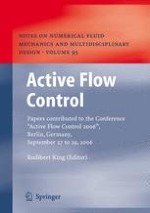The dramatically increasing requirements of mobility through road-, rail- and airborne transport systems in the future necessitate non-evolutionary impro- ments of transportation systems. Without severe implications concerning the environment or restrictions concerning the performance, these requirements will only be met by a concerted action of many disciplines. It is believed that with ACTIVE FLOW CONTROL a key technology exists to supply an important block in the mosaic to be laid in the pursuit of best and sustainable solutions. Manipulation of ?uid ?ows is highly advantageous in many cases. Aerodynamic or?uid?owsaroundorinsidebodies imposedrag,liftandmoments onthebody, removeor supply energy by convection. Flow-induced noise may be produced by the interaction of a body with the surrounding air. Moreover, the interaction with the body changes the state of the ?ow drastically. A neatly aligned laminar ?ow around a wing of an aircraft giving enough lift, can become highly irregular and separatedfrom the surface,with the result of a loss of lift. For cooling of - gines of transportand other systems highly irregular turbulent ?uid ?ows across the components are needed to guarantee a large heat transfer. In future engines of airplanes complying for example with the EU Vision 2020 an increased heat transfer, on the other hand, has to be avoided by all means in some parts of the engine. Turbine stages may be exposed here to extremely hot gases, needed for highe?ciency,whichwoulddestroythe blades. Inthis application,morelaminar ?ow regimes would be advantageous yielding a poorer heat transfer. Theirregular?owinacombustore. g.
